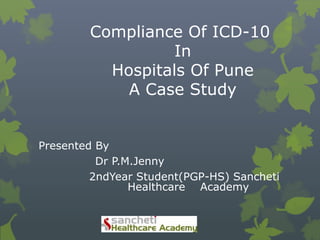Compliance of icd 10 in hospitals of pune
- 1. Compliance Of ICD-10 In Hospitals Of Pune A Case Study Presented By Dr P.M.Jenny 2ndYear Student(PGP-HS) Sancheti Healthcare Academy
- 4. Introduction ? International classification of diseases and related health problems 10 th version (ICD-10) is the international standard prescribed by WHO. Countries need to adopt and implement it so that the morbidity and mortality data are comparable within countries and inter countries. ? ICD is a medical classifications that provides codes to classify diseases and a wide variety of signs, symptoms, abnormal findings, complaints, social circumstances, and external causes of injury or disease
- 5. Objective ? To find out the compliance of ICD-10 codes in hospitals ? Response of Clinicians & Paramedical staffs ? Scope of improvements ? Benefit analysis
- 6. Benefit of ICD-10 ? Mortality reporting ? Morbidity reporting ? Epidemiological reporting ? Mediclaim reimbursements ? Health planning ? Resource allocations ? Medical tourism ? Data portability in different systems ? Medical research
- 7. Methodology ? Cross sectional study ? Sample size- 20 hospitals o 5 hospitals >200 beds o 2 hospitals =100 beds o 13 hospitals< 100 beds ? Depth interview o Statistician o Professors o Doctors
- 8. Finding ON 16 14 12 10 8 Yes 6 4 2 0 No 1of Hospitals using ICD-10 2
- 9. Bed wise hospitals 200-500 bed yes >100 bed NO 100 bed Yes
- 10. CliniciansˇŻ Response Doctor's response about ICD-10 knows about ICD- MRD 10, 20% department, 46.46% Death certificate, 3 3%
- 11. Challenges ? Diagnosis not written (OPD and IPD) properly, reason: o Short forms o Illegible o Without secondary diagnosis o Other morbid conditions ? Less initiative by hospital authorities ? Benefit analysis is not in place ? Inadequate Electronic methods for data collections and software technologies ? Strong government initiative ? Less trained manpower
- 12. Recommendations ? Cost, effort and benefit analysis ? Adoptions of electronic methods ? Customized soft ware technologies from various EMR Vendors ? Capacity building initiatives, workshops, who facilitated ICD -10 soft wares and initiatives by private hospitals ? Inclusion of ICD 10 in the UG and PG curriculum of medical courses ? Department wise codes display ? Hand outs and manuals in recording data in primary level having ICD codes and training for the same ? Support from the medical fraternity in implementation
- 13. Present advancement ? National Library of MedicineˇŻs Unified Medical Language System (UMLS). ? Mechanism for the distribution of clinical terminologies and classifications ,mappings between terminologies and between terminologies and classifications. ? The maps will be distributed via the UMLS Met thesaurus. ? The ICD-11 will be available in 2015
- 14. Scope for health care professionals ? Training and orientation ? Software having ICD-10 compliance ? Format of prescriptions ? Data capturing manuals ? Medical record department
- 17. Examples ? Apollo Hospital ? ICD 10 implemented since 1993. MRD inter-linked through LAN with OPD emergency and IPD ? Medical Records are scanned and stored in electronic format ? PGI Rohtak ? Booklet containing 20 pages of ICD 10 3 digit codes on ? The basis of all the three volumes of ICD 10 book was framed. ? Involvement of ICD 10 in UG, PG medical curriculum , ? Availability of Window based ICD 10 software, ? Senior faculty members be made aware of ICD 10 and its utility
- 18. Conclusion ? Information is used as technology & created from Data ? Tool, collection methods, credibility, Uniformity and validity ? Medical science itself has survived on data ? ICD 10 will help in o Health planning o Forecasting of disease patterns o Resource allocation o Clinical decision support system o Research o Compliance with MOCRA
- 19. Reference ? SHIB(state health intelligence bureau) ? BJ medical college ? Ruby hall clinic ? Jehangir hospital ? Noble hospital ? Sahyadri hospital ? Sancheti orthopedic hospital ? Poona research center ? ABMH (Aditya Birla Memorial Hospital) ? Columbia Asia
Editor's Notes
- A classification of diseases may be defined as a system of categories to which morbid entities are assigned according to established criteria. Extracted from ICD-10 Second Edition, 2005, 1: Tabular List.
- ICD 10 coding was introduced by WHO in the year 1993 and India adopted the same in the year 2000. l records coded uniformly using ICD 10 form a vast data base and conclusions drawn on the processed data are extremely important for understanding the public health situation of the country.
- out of 192 member countries of WHO in the world, 109 countries have implemented ICD 101: Tabular List2: Instruction Manual3: Alphabetical
- Analysis of morbidity records by a health facility will provide information on the treatment load by different specialties and will help to make provision for tackling the load in a hospital. analysis of mortality records of a facility will indicate those diseases and health problems which are the underlying causes of death in the particular area
- ICD 10 coding is being done by the doctors. No files in MRD are taken without proper coding.
- Maintenance of Clinical Records Act (MOCRA)




















